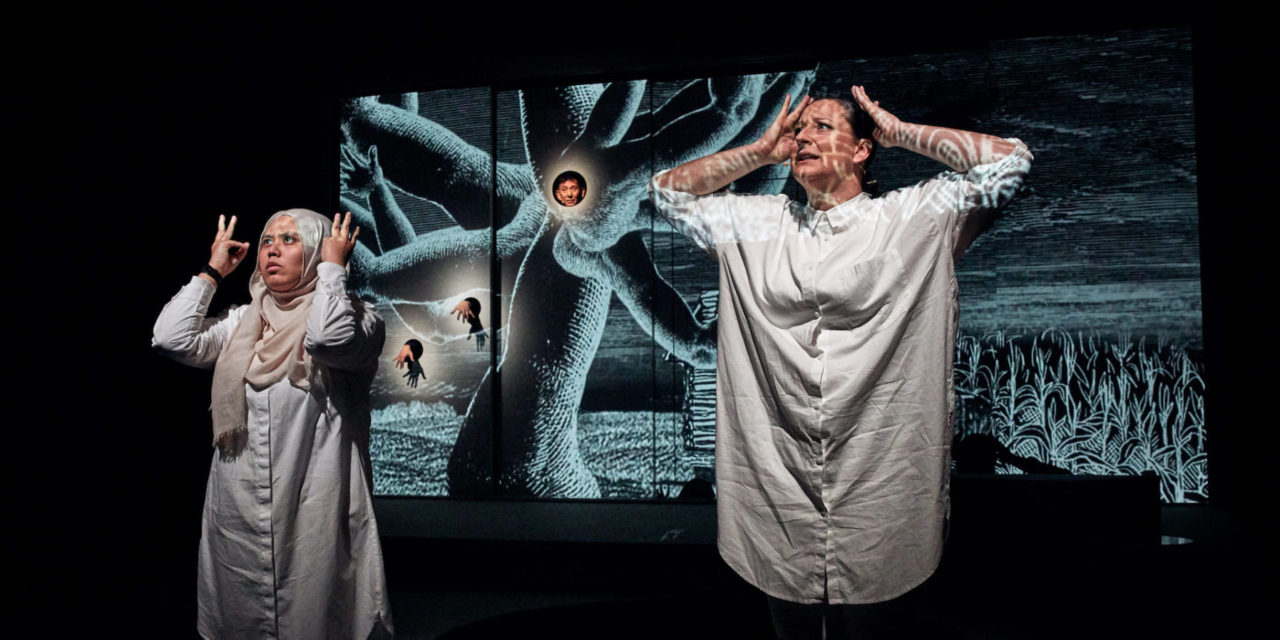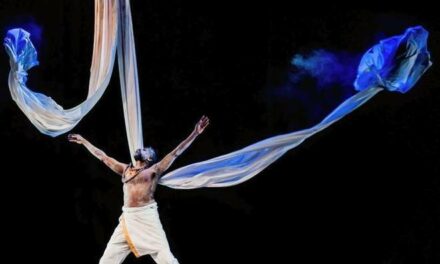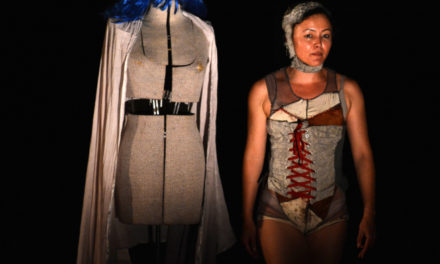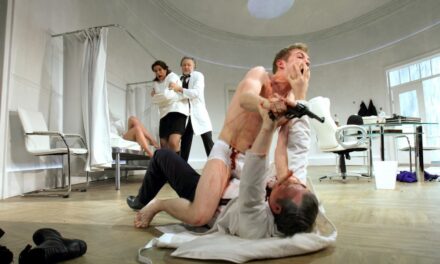Corrie Tan: When Edith Podesta first told us during our Studios podcast interview that Leda And The Rage would feature the life and paintings of Artemisia Gentileschi, I felt a jolt of excitement–I’d seen her work at an exhibition at the National Gallery in London, specifically one of her Susannah And The Elders paintings (below), and in the gallery she’d been flanked by a horde of other Baroque painters–all male. You can see how she’s painted herself into the center of this image, how she’s holding on to the last shreds of her innocence, her eyes welling up with tears (what’s she looking at? her past? a divine interceder?) as two leering men claw at each other to peer over her naked shoulder.
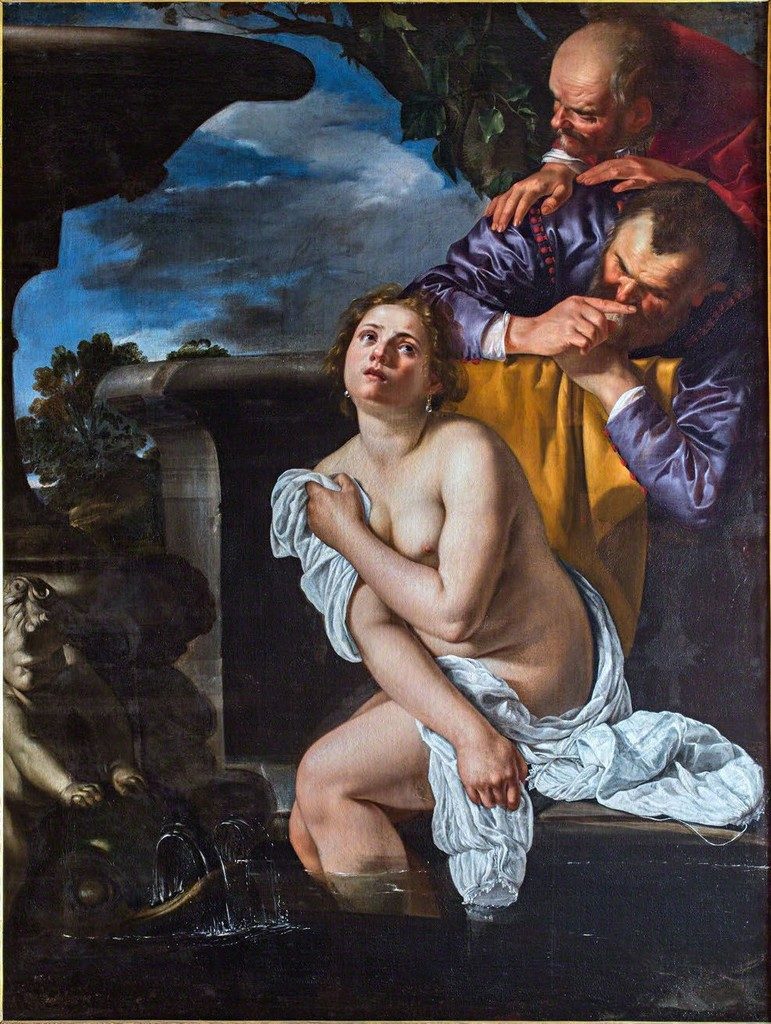
Susannah And The Elders, 1622. Oil on canvas, 161.5 × 123 cm Beyond Caravaggio at National Gallery, London © The Burghley House Collection
Akanksha Raja: I remember seeing a work by Gentileschi in Europe and learning about her then. It wasn’t Susannah And The Elders–I don’t remember what it was. But that was the first time I’d heard of a female Baroque painter.
Leda And The Rage opens with an art history lecture by an academic played by Podesta, on depictions of rape in the classical and Baroque periods. The unnamed academic–who specializes in depictions of trauma in art–begins the lecture discussing Gentileschi’s preoccupation with this biblical story (she created several different paintings of Susannah And The Elders throughout her life) and how it draws on the artist’s personal experiences. Gentileschi was repeatedly raped by her father’s friend, painter Agostino Tassi. The academic quotes transcripts from Gentileschi’s trial, which included her being tortured to “make sure” she was not lying. Following Gentileschi’s story, we learn more about the academic who is also coping with her own trauma of sexual assault. We follow her through her therapy sessions, where she discusses the destructive effect of her trauma on her life. We delve into her inner world, where she dialogues with women from Greek myths: Persephone, Daphne, Leda, all survivors of rape. The “past” and the “present” aren’t distinct in this performance, highlighting the pervasiveness of rape culture and how little has changed over millennia.
Corrie: The linchpin of Leda And The Rage is exactly that: if it’s possible to exorcise trauma through art. This works on so many levels: we have the academic, played by Podesta, as she goes for therapy with the same psychiatrist (Jeremiah Choy) who’s giving a parallel lecture on how to address sexual assault as a medical worker in Singapore. Then there are the dozens of female characters from Ovid’s Metamorphoses who have been subjected to rape from gods, demi-gods, and other celestial creatures (such as Leda And The Swan, from which the piece takes its title) who find a different voice through Podesta’s various characterizations as she reimagines their responses to what they’ve had to live through. Then there’s us, the audience, going through our own Aristotelian catharsis as we watch the play.
I wonder if to exorcise is to rewrite, to reclaim, to take newfound ownership–which is exactly what Podesta does in her subversion of Ovid’s tales. These women, untimely transformed into other creatures before they could exact their own acts of revenge, find new voices. Gentileschi went on to paint her dramatic, bloody masterpiece of Judith Slaying Holofernes after the rape trial and enjoyed tremendous professional success.
Akanksha: Leda is about healing, and healing is about exactly what you said–reclaiming your agency, owning your truth. In Leda And The Rage, water is a motif of healing. A glistening black pool centers Wong Chee Wai’s monochrome set, and it signifies a place of solidarity where the academic meets with Medusa and survivors of wartime rape from Nanking, Rwanda, Congo, the Sabines, etc. The mythical character of Medusa is subverted–often depicted as a “monster,” here she’s become a healer. The image of the snake, which is similarly regarded as evil–the creature that seduced Eve to sin–coils around Podesta’s character to comfort and protect her. Medusa helps her to heal by guiding her to “choose a moment before you became conscious…so the reptile sees the reptilian brain”: the academic recounts her father walking in on her playing in the bath as a child, when she discovers her vagina; her father respectfully advises her to take care and gives her privacy–a memory where she had autonomy of her own body. In the evocative final scene, the pool turns into a giant shower where the academic cleanses herself and re-affirms, limb by limb, joint by joint, her ownership of her body.

Edith Podesta (left) and Amirah Osman. Photo by Crispian Chan, courtesy of Esplanade–Theatres on the Bay
Corrie: Can we talk about the stunning lyricality of Podesta’s writing for a moment here? (Edith, please publish your scripts.) We got some of this in Podesta’s similarly densely-written BITCH: The Origin Of The Female Species (2016), where she also reclaims a word women have been saddled with as an insult. In Leda And The Rage, Podesta takes the epic poetry form and runs with it. The language is dramatic, precise, musical; I took down so many snippets I loved that reclaimed words like “my c(o)untry.” Other phrases:
- In a cornfield, a maze of maize, “all ears are recoiling into husks” after a terrible act
- Women are “mulched into Ovid’s pulp fiction”
- The academic’s “grazed labia stings, sings”
- My personal favorite: “I sharpen the shards of my sadness on the whetstone of my clit.”
The sound of the text as Podesta savors these phrases and allows them to sit with us–it’s one of the things I most enjoy about her work. She uses these beautiful verses to recount some of the most horrific moments of the plot; she doesn’t paper over the brutality of rape or assault, but understands how–as you pointed out with the snake, or Medusa–you can transform an object of cruelty, of pain, of violence (in a reverse-Ovidian way) into a thing of beauty. This, coupled with sumptuous multimedia elements by artist Brian Gothong Tan, who projects and manipulates large-scale baroque and classical paintings against the clean back wall of Wong’s set.
Akanksha: Tan’s original monochrome animations, such as of the wavering laurel tree–representing Daphne, who turned into a tree during her assault by Apollo–imbues a oneiric quality that complements Podesta’s poetry exquisitely.
Corrie: Something that jolted me from this beautiful, torrential poetry was Choy’s more tentative performance; this is his first stage show in something like a decade. I get the sense that this was deliberate and that Podesta as director focuses on a realistic artlessness in his delivery. He’s positioned stage right, in black, and the art academic is stage left, in white, so they’re playing off each other. Choy’s holding on to his lecture notes and reading from them with clinical remove, including reams of sexual assault statistics; Podesta’s account is much more explosive, visceral. The same happens in the therapy room, where he’s a quieter, more measured presence to her barely-suppressed rage and exasperation. Then again, Choy does stumble over his words, which made me think of his performance rather than of the contrast between the two narratives–that of statistics and that of lived experience.
Akanksha: His performance was looser. But I think his role here doesn’t necessitate a “perfect” delivery–he provides an expository counterpoint to Podesta’s theatrical narrative, and I think that stumbling in reading out the case studies has a humanness to it. It made me think of how overwhelming the real significance of these numbers are.
Corrie: That’s a good point. And a performer who was any less generous or tender than Choy was–deferring to Podesta’s presence on stage and allowing her story to take the spotlight–would have destroyed what the show was trying to do, which is allowing the female voice to take the reins instead of being shut down or maligned.
Akanksha: Exactly. Choy is the only representation of the male body in the play’s world, and his presence could have perpetuated the archetype of the male as the infallible and impartial scribe of historical fact. But his presence as a feminist male–one without the need for dominance and supremacy that is encoded in masculine performativity–made the play’s feminism feel well-rounded and inclusive. I adored that toxic masculinity found no embodiment, no voice, in Leda.

Jeremiah Choy (left) and Edith Podesta. Photo by Crispian Chan, courtesy of Esplanade–Theatres on the Bay
Corrie: So much of the entire experience of this play felt personal, even if the events (stranger rape, pedophilia, etc) aren’t things that Podesta herself has experienced. But these various degrees of gender-based violence are so familiar to women–all women–from harassment to molest to rape. I usually have a quick glance at the audience members around me before a show to get a sense of the theatre-going demographic, and the evening we watched the show I’d say the audience was about 80-90% women. You talked about how Gentileschi was tortured in the process of “lie detection” for the rape trial, and it’s impossible, as a woman, not to hear the anger and frustration in her refrain:
“It is true, it is true, it is true.”
Akanksha: Anger is integral to the play. In one scene, Podesta’s character is reporting her sexual assault to French policemen, where her translator is clearly being insensitive. It reflects the frustration many sexual assault survivors face: being second-guessed and cross-examined about whether they are lying. As Podesta’s character’s frustration grows, this scene intersperses with the forensic psychiatrist’s exposition on rape statistics, which goes to show that the art academic’s anger does not stem from her being “sensitive” or “irrational,” but is a reaction coalesced over years, to the larger-than-life force of rape culture that permeates everyday life.
The only physical space where Podesta’s character feels safe and heard is in the therapy room. It was moving when Podesta’s character tells her therapist,
“Thank you for holding this space for me.”
Theatre like this creates such a space. It is more than just a dramatic catharsis–some art takes lived experience and turns it into a spectacle of pathos but scant substance or real social relevance. I appreciated the involvement of AWARE’s sexual assault support services, both in the pre-show workshop as well as the post-show dialogues. To have a space where such experiences and traumas are validated–this is a great example of socially engaged art.
Corrie: Both of us stayed for the post-show dialogue, where dramaturg Rosemary McGowan, AWARE representative Lim Xiu Xuan, and Podesta responded to questions about Leda And The Rage, as well as questions that dealt with sexual assault and rape culture. The Q&A felt like a natural extension of Leda; in fact, I think the space for this intimate dialogue–the very same space you’ve described–was both integral to and a result of the show, which doesn’t set itself apart from challenging real-life discussions of sexual assault, trauma, and recovery.
Akanksha: The Q&A felt like the play coming full circle. The performance starts as a make-believe lecture that positions the audience as students, but that conceit dissolves over the course of the performance and does not return until post-show. It manifests the fact that what is taught in the classroom extends beyond academic spaces–whether it’s art history, forensic psychiatry, sociological statistics–in the same way, that the reality of trauma and rape culture goes beyond what is studied academically.
This is also the first performance I’ve watched that had sign-language interpreters seamlessly involved in the performance. Amirah Osman and Jun An from the Singapore Association for the Deaf not only shadowed Podesta’s and Choy’s characters respectively, they also effectively mirrored each character’s emotional nuances.
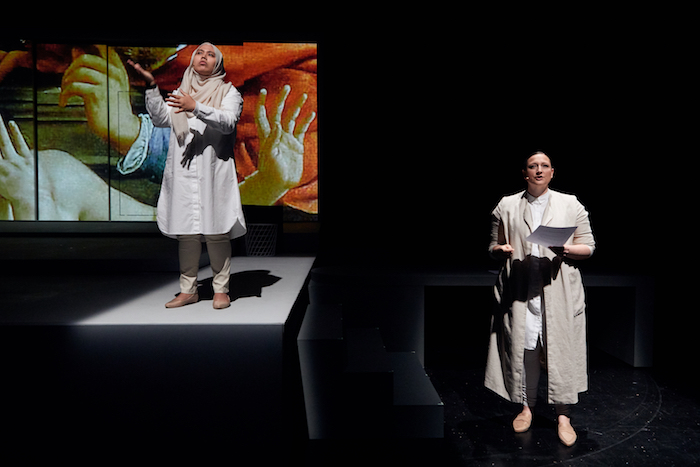
Amirah Osman (left) and Edith Podesta. Photo by Crispian Chan, courtesy of Esplanade–Theatres on the Bay
Corrie: This is the final show of this year’s The Studios season. When we were talking to all the theatremakers behind this season before it opened, there was a lot of affectionate ribbing about how Edith’s was the only production that wasn’t a monologue, which had been the Esplanade producers’ initial brief for the entire season. Of course no one can quite determine how a work grows, but in this case, I think the solo voice does emerge, strengthened by the fact that it is legion.
Akanksha: It was a truly inspiring season. Hats off to Esplanade’s programming team! All of the works handled complex issues with grace, intelligence, and wit. The monologue form brought forth an introspective quality which I’d love to see more of in local theatre. In our hyper-connected world, I think people don’t explore aloneness enough. I recall during our podcast discussion you talked about how theatre produced by female-identifying makers is often seen as “personal” as opposed to “universal” and Michelle Tan’s response that the personal is the universal–this season is a testament to that.
Corrie: I’ve become very fond of all of the characters holding the fort this season, from Faith Ng’s Dr. Leong to Michelle Tan’s Risa to Kaylene Tan’s Thian. They are vulnerable, confiding, and remarkably strong. During the post-show dialogue for I Am Trying To Say Something True, Ellison Tan, who played Risa, said that she’d gone for coffee with actress Karen Tan, who played Dr. Leong, to commiserate about how lonely it gets on the monodrama stage. Singapore has an abundance of wonderful monodramas for women, whether it’s Stella Kon’s iconic Emily Of Emerald Hill (1984), Huzir Sulaiman’s Occupation (2002), Haresh Sharma’s Rosnah (1995), or Elangovan’s Talaq (1998). This season has added a few more women-driven monodramas to that canon. I don’t think that loneliness, that aloneness, is something to be ignored. There’s something familiar and powerful when it comes to the woman walking alone, whether on the bright stage or on a dark, quiet street. It says: I am here and I am not afraid–or, even if I am afraid, I am still here.
By Akanksha Raja & Corrie Tan
Leda And The Rage, written and directed by Edith Podesta and performed by Edith Podesta and Jeremiah Choy (together with sign interpreters Amirah Osman and Jun An from the Singapore Association for the Deaf), ran from 26 – 29 April at the Esplanade Theatre Studio. This review is based on the performance on 27 April.
This post was written by the author in their personal capacity.The opinions expressed in this article are the author’s own and do not reflect the view of The Theatre Times, their staff or collaborators.
This post was written by Arts Equator.
The views expressed here belong to the author and do not necessarily reflect our views and opinions.

